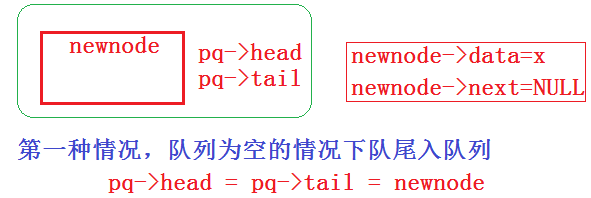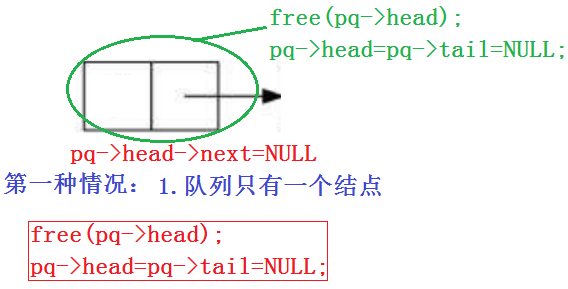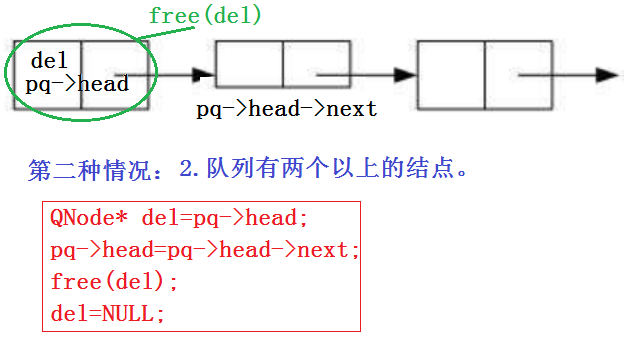队列的接口实现(附图解和源码)
文章目录
前言
本文主要介绍对列中增删查改等接口实现,结尾附总源码!
一、定义结构体
在这里我们用链表的结构实现队列!(效率比数组高)

这里和单链表不同的是:需要定义两个结构体!一个表示链式结构队列,另一个是队列的结构。
代码如下(示例):
typedef int QDataType;
typedef struct QueueNode
{
struct QueueNode* next;
QDataType data;
}QNode;
typedef struct Queue
{
QNode* head;
QNode* tail;
int size;
}Queue;
二、接口实现(附图解+源码)

这里一共8个接口,我会一 一 实现(源码+图解)
1.初始化队列
初始化队列和单链表初始化时一致,详细的可以参考单链表初始化!
代码如下(示例):
void QueueInit(Queue* pq)
{
assert(pq);
pq->head = pq->tail = NULL;
pq->size = 0;
}
2.销毁队列
 最后不要忘了把pq->head和pq->tail置为NULL
最后不要忘了把pq->head和pq->tail置为NULL
代码如下(示例):
void QueueDestroy(Queue* pq)
{
assert(pq);
QNode* cur = pq->head;
while (cur)
{
QNode* del = cur;
cur = cur->next;
free(del);
}
pq->head = pq->tail = NULL;
}
3.队尾入队列
先用 malloc 开辟一个 newnode 空间!


代码如下(示例):
void QueuePush(Queue* pq, QDataType x)
{
assert(pq);
QNode* newnode = (QNode*)malloc(sizeof(QNode));
if (newnode == NULL)
{
perror("malloc fail");
exit(-1);
}
else
{
newnode->data = x;
newnode->next = NULL;
}
if (pq->tail == NULL)
{
pq->head = pq->tail = newnode;
}
else
{
pq->tail->next = newnode;
pq->tail = newnode;
}
pq->size++;
}
既然要不断判断链表是否为空,我们应该写一个 判断队列是否为空的函数。
4.判断队列是否为空
如果为空返回非零结果,如果非空返回0
代码如下(示例):
bool QueueEmpty(Queue* pq)
{
assert(pq);
return pq->head == NULL && pq->tail == NULL;
}
5.队头出队列
注意:删除头对列时要注意队列可以为空,所以用assert进行断言!

这里也分两种情况:1.队列只有一个结点,2.队列有两个以上的结点。


6.获取队列头部元素
直接返回 pq->head->data 即可。
代码如下(示例):
QDataType QueueFront(Queue* pq)
{
assert(pq);
assert(!QueueEmpty(pq));
return pq->head->data;
}
7.获取队列尾部元素
直接返回 pq->tail->data 即可。
代码如下(示例):
QDataType QueueBack(Queue* pq)
{
assert(pq);
assert(!QueueEmpty(pq));
return pq->tail->data;
}
8.获取队列中有效元素个数
直接返回 pq->size 即可
代码如下(示例):
int QueueSize(Queue* pq)
{
assert(pq);
return pq->size;
}
如果我们没有在结构体中定义 size 应该怎么做?

代码如下(示例):
int QueueSize(Queue* pq)
{
assert(pq);
QNode* cur = pq->head;
int n = 0;
while (cur)
{
++n;
cur = cur->next;
}
return n;
}
三、源代码展示
1.test.c(测试+主函数)
代码如下(示例):
//#include <stdio.h>
//
//int f(int n)
//{
// return n == 1 ? 1 : f(n - 1) + n;
//}
//
//int main()
//{
// printf("%d\n", f(10000));
//
// return 0;
//}
#include <stdio.h>
#include "Stack.h"
#include "Queue.h"
// 解耦 -- 低耦合 高内聚
// 数据结构建议不要直接访问结构数据,一定要通过函数接口访问
void TestStack()
{
ST st;
StackInit(&st);
StackPush(&st, 1);
StackPush(&st, 2);
StackPush(&st, 3);
printf("%d ", StackTop(&st));
StackPop(&st);
printf("%d ", StackTop(&st));
StackPop(&st);
StackPush(&st, 4);
StackPush(&st, 5);
while (!StackEmpty(&st))
{
printf("%d ", StackTop(&st));
StackPop(&st);
}
printf("\n");
}
void TestQueue()
{
Queue q;
QueueInit(&q);
QueuePush(&q, 1);
QueuePush(&q, 2);
QueuePush(&q, 3);
printf("%d ", QueueFront(&q));
QueuePop(&q);
printf("%d ", QueueFront(&q));
QueuePop(&q);
QueuePush(&q, 4);
QueuePush(&q, 4);
QueuePush(&q, 4);
while (!QueueEmpty(&q))
{
printf("%d ", QueueFront(&q));
QueuePop(&q);
}
printf("\n");
QueueDestroy(&q);
}
int main()
{
//TestStack();
TestQueue();
return 0;
}
2.Queue.h(接口函数的声明)
代码如下(示例):
#pragma once
#include <stdio.h>
#include <stdlib.h>
#include <assert.h>
#include <stdbool.h>
typedef int QDataType;
typedef struct QueueNode
{
struct QueueNode* next;
QDataType data;
}QNode;
typedef struct Queue
{
QNode* head;
QNode* tail;
int size;
}Queue;
void QueueInit(Queue* pq);//初始化队列
void QueueDestroy(Queue* pq);//销毁队列
void QueuePush(Queue* pq, QDataType x);//队尾入队列
void QueuePop(Queue* pq);//队头入队列
QDataType QueueFront(Queue* pq);//获取队列头部元素
QDataType QueueBack(Queue* pq);//获取队列尾部元素
bool QueueEmpty(Queue* pq);//判断队列是否为空
int QueueSize(Queue* pq);//获取队列中有效元素个数
3.Queue.c(接口函数的实现)
代码如下(示例):
#include "Queue.h"
void QueueInit(Queue* pq)
{
assert(pq);
pq->head = pq->tail = NULL;
pq->size = 0;
}
void QueueDestroy(Queue* pq)
{
assert(pq);
QNode* cur = pq->head;
while (cur)
{
QNode* del = cur;
cur = cur->next;
free(del);
}
pq->head = pq->tail = NULL;
}
void QueuePush(Queue* pq, QDataType x)
{
assert(pq);
QNode* newnode = (QNode*)malloc(sizeof(QNode));
if (newnode == NULL)
{
perror("malloc fail");
exit(-1);
}
else
{
newnode->data = x;
newnode->next = NULL;
}
if (pq->tail == NULL)
{
pq->head = pq->tail = newnode;
}
else
{
pq->tail->next = newnode;
pq->tail = newnode;
}
pq->size++;
}
void QueuePop(Queue* pq)
{
assert(pq);
assert(!QueueEmpty(pq));
if (pq->head->next == NULL)
{
free(pq->head);
pq->head = pq->tail = NULL;
}
else
{
QNode* del = pq->head;
pq->head = pq->head->next;
free(del);
del = NULL;
}
pq->size--;
}
QDataType QueueFront(Queue* pq)
{
assert(pq);
assert(!QueueEmpty(pq));
return pq->head->data;
}
QDataType QueueBack(Queue* pq)
{
assert(pq);
assert(!QueueEmpty(pq));
return pq->tail->data;
}
bool QueueEmpty(Queue* pq)
{
assert(pq);
return pq->head == NULL && pq->tail == NULL;
}
int QueueSize(Queue* pq)
{
assert(pq);
/*QNode* cur = pq->head;
int n = 0;
while (cur)
{
++n;
cur = cur->next;
}
return n;*/
return pq->size;
}
总结
以上就是今天要讲的内容,本文介绍了队列8种接口的模拟实现的图解+源代码
如果我的博客对你有所帮助记得三连支持一下,感谢大家的支持!
























 443
443











 被折叠的 条评论
为什么被折叠?
被折叠的 条评论
为什么被折叠?








